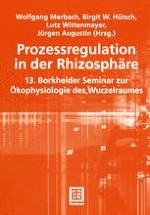2003 | Buch
Prozessregulation in der Rhizosphäre
13. Borkheider Seminar zur Ökophysiologie des Wurzelraumes
herausgegeben von: Wolfgang Merbach, Birgit W. Hütsch, Lutz Wittenmayer, Jürgen Augustin
Verlag: Vieweg+Teubner Verlag
Enthalten in: Professional Book Archive
